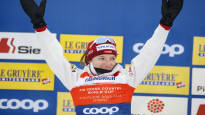Nadine Fähndrich said that she returned to the skiing World Cup just two weeks after heart surgery. Finnish sports cardiologist Kirsi Korpi explains how it is possible.
Swiss skiing star Nadine Fähndrich made a splash earlier this week when he revealed that he was back just two weeks after heart surgery for the World Cup.
Fähndrich still returned straight to the top. On Tuesday, he was in the finals of the World Cup sprint for traditional skiing in Drammen and finished fifth. Fähndrich was again in the final and sixth in the sprint of the final weekend of the World Cup in Falun on Friday.
Fähndrich told the Norwegian public broadcasting company NRK in Drammenthat he had arrhythmias in his heart and had undergone surgery.
According to the Swiss, he had had big problems during the season, especially on longer trips. Last season, Fähndrich fought for the Sprint Cup victory on the final weekend of the World Cup. According to his own words, he didn’t have such big problems last season.
A month ago, Fähnrich stopped the 20 km co-start race due to heart problems at the Canmore World Cup in Canada. Even after that, Fähndrich competed in the North American tour in Minnesota and was fourth in the sprint race until he took a break from the competition.
Sports cardiologist Kirsi Korpi believes, based on media reports, that Fähndrich has had a fairly benign arrhythmia, but when it occurs during exercise, it prevents competitive sports. Fähndrich may have had problems with an activated shunt in his heart.
Based on the recovery schedule, the sports cardiologist suspects that Fähndrich had supraventricular tachycardia, or SVT.
– The actual recovery is the recovery of the puncture site, usually the groin. When such procedures are performed, a puncture is made in the groin vein and the procedure catheters are inserted into the heart from this point. Groin recovery usually takes about two weeks. That’s how much time is recommended before starting to make an effort, Korpi opens.
SVT is treated with a so-called ablation procedure. The straight line is cut off. It does not affect the heart. This kind of behavior is common.
From similar right-track type arrhythmias said at the time that he had suffered swimmer Jani Sievinen. His arrhythmia was corrected with an operation to affect the nerves that control the heart’s rhythm.
– The right track can be activated at any time at any age, from baby to adult. It is partly hereditary, Korpi describes on a general level.
If the arrhythmia were atrial fibrillation in the heart, the return would not be so quick.
– Then treatment measures have to be carried out in a wider area. It means that the resting heart rate often stays higher for a few months. Then returning to competitive sports is usually not possible this quickly, says Korpi, who works at the Helsinki Heart Center.
If we think about anyone, not just a top athlete, when should we worry that there is something wrong with the heart?
– When you get chest pain, especially repeatedly, be it at rest or during exertion, you should go find out, underlines Korpi.
Sometimes heart problems can also manifest as a decrease in performance.
In a young person, chest pain can occasionally be of skeletal origin, but chest pain that occurs during exertion must always be investigated.
– If you experience palpitations or other types of dysrhythmias, and especially related dizziness or malaise, that should also be investigated.
